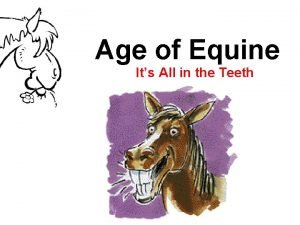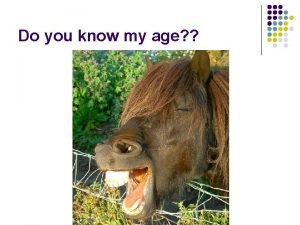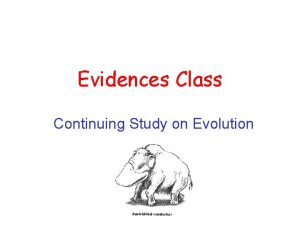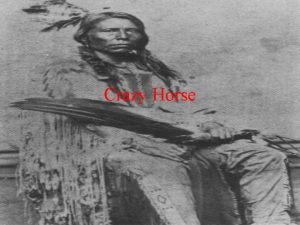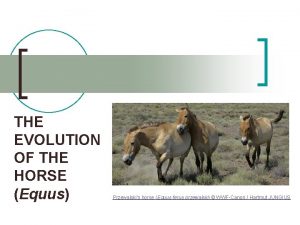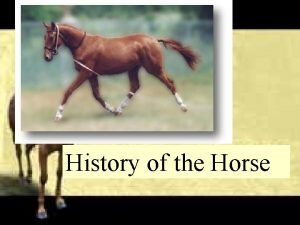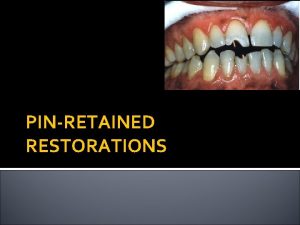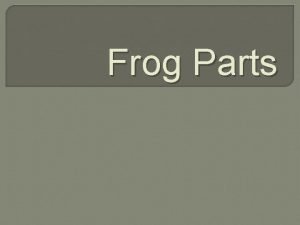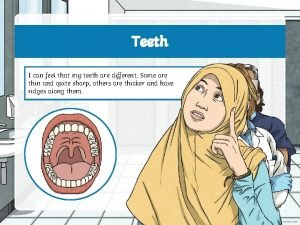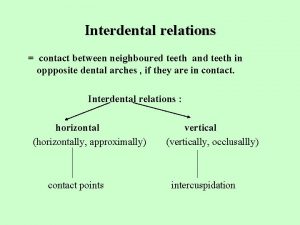EVOLUTION OF THE HORSE A LOOK AT TEETH
















- Slides: 16

EVOLUTION OF THE HORSE: A LOOK AT TEETH Kaelin Creange

The Question at Hand • How have horses’ teeth adapted to their more evolutionarily recent niche of grazers versus browsers?

The Modern Equine Skull • Long face to accommodate large crown reserves of grinding teeth, and set of cropping teeth in the front • Deep mandible, allowing for large masseter muscles that enable grinding type mastication.

Tooth Structure • Horse teeth have evolved hypsodonty, which means they have a high crown. • This allows them more tooth to wear down, thus being able to utilize a tougher food source • Presence of cementum increases the hardness of the tooth. • Also creates ridges on the occlusal surface of the tooth, which aids in more effective grinding • Born with full set of fully developed adult teeth • Milk teeth precede the eruption of the adult teeth, which will continuously erupt throughout their lifetime. “crow n descri ” is be the en d as a cover mel e above d area the g um line

The Mouth INCISORS Center Lateral Corner WOLF TOOTH (premolar 1) MOLARS (3) PREMOLARS (3) CANINES (premolars and molars are virtually the same size and shape)

Mastication • Grinding, circular motion • Aids in eating grasses, which are an abrasive, fibrous food source – Condemns the teeth to a great deal of wear (avg 23 mm/yr)

Looking at the Evolution • Early horses (Eohippus, Orohippus, Mesohippus) – Short crowned – No cement on the outside of tooth – Premolars smaller than molars (4 premolars, 3 molars) • Later horses (Merychippus, Pliohippus, Equus) – High crowned (hypsodonty) – Teeth covered in cement – Premolars resemble molars (except pm 1; very small)

A. Example of a brachydont (human) B. Examle of a hypsodont (horse)

Caroline A. E. Stromberg • Examined the hypothesis that hypsodonty in equids evolved as an adaptation to the emergence of grassdominated habitats • Compared the timing of the emergence of the taxa first displaying hypsodonty (along with sister taxa having mesodont and brachydont teeth) with the emergence of grassdominated habitats in the Great Plains of North America.

Crown Height in Relation to Occurrence of Taxa

Which phylogenic tree? Black bar = trait of hypsodonty Grey bar = appearance of the demand for feeding on grass

Stromberg’s Results • Hypsodonty fully present in members of Equinae (~18 mya) – Equinae emerged at least 4 my after the earliest open, grass-dominated habitats. – With this 4 million year gap, does this result support hypsodonty as an adaptation to increasing dominance of open grasslands?

Stromberg’s Results cnt. • Parahippus possible intermediate taxa between brachydont and hypsodont taxa? – – Were mixed feeders (grazed and browsed) Increased crown height (mesodonts) Emerged almost same time as open-grasslands Species within taxa showed a thicker, and (modestly) modified radial enamel that are similar to some characteristics of the hypsodont horses of Equinae • This suggests that small changes were made over much longer time periods than initially thought – supports ?


Future Research • How genetically similar are Parahippus and Equinae taxa? – This could shed light on if parahippus is in fact very closely related to equinae, or if there is another intermediate taxa between them.

REFERENCES • • • Cerling, T. E. , Harris, J. M. , Mac. Fadden, B. J. , and Prado, J. 1999. Ancient latitudinal gradients of C 3/C 4 grasses interpreted from stable isotopes of new world pleistocene horse (Equus) teeth. Global Ecology and Biogeography 8: 137 -149. Dacre, I. T. 2006. Physiology of mastication. American Association of Equine Practitioners (reproduced in the IVIS website). Kainer, R. A. , Mc. Cracken, T. O. 1998. Horse anatomy, a coloring atlas. Loveland, CO: Alpine Publications, Inc. Matthew, W. D. 1926. The evolution of the horse: a record and its interpretation. The Quarterly Review of Biology 1: 139 -185. Mc. Kenna, M. C. 1993. Review: the horse tree. Science 260: 1156 -1157. Strömberg, C. A. E. 2006. Evolution of hypsodonty in equids: testing a hypothesis of adaptation. Paleobiology 32: 236 -258.
 Look down look up
Look down look up Bishoping horses
Bishoping horses Hypsodont teeth horse
Hypsodont teeth horse Anisognathic
Anisognathic Prehistoric horse
Prehistoric horse Horse evolution chart
Horse evolution chart Look at the picture in activity 1
Look at the picture in activity 1 Activity 1 picture talk
Activity 1 picture talk Look at activity 1 and answer
Look at activity 1 and answer Thế nào là hệ số cao nhất
Thế nào là hệ số cao nhất Sơ đồ cơ thể người
Sơ đồ cơ thể người Tư thế ngồi viết
Tư thế ngồi viết Hình ảnh bộ gõ cơ thể búng tay
Hình ảnh bộ gõ cơ thể búng tay đặc điểm cơ thể của người tối cổ
đặc điểm cơ thể của người tối cổ Bàn tay mà dây bẩn
Bàn tay mà dây bẩn Mật thư tọa độ 5x5
Mật thư tọa độ 5x5 ưu thế lai là gì
ưu thế lai là gì

